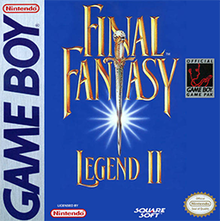
Back Final Fantasy Legend II French Final Fantasy Legend II Italian Sa・Ga2 秘宝伝説 Japanese 사가 2: 비보전설 Korean Final Fantasy Legend II LLD Final Fantasy Legend II Russian Final Fantasy Legend II Swedish 沙加2 秘宝传说 Chinese
| Final Fantasy Legend II | |
|---|---|
 North American Game Boy box art | |
| Developer(s) | Square[a] |
| Publisher(s) | Game Boy Square Nintendo DS, Nintendo Switch Square Enix |
| Director(s) | Akitoshi Kawazu |
| Designer(s) | Akitoshi Kawazu Hiromichi Tanaka Toshiyuki Inoue |
| Programmer(s) | Naoki Okabe Tomoki Anazawa |
| Artist(s) | Katsutoshi Fujioka |
| Writer(s) | Akitoshi Kawazu |
| Composer(s) | Nobuo Uematsu Kenji Ito |
| Series | SaGa[b] |
| Platform(s) | Game Boy, Nintendo DS, Nintendo Switch, Android, iOS, Microsoft Windows |
| Release | Game BoyNintendo DS
|
| Genre(s) | Role-playing |
| Mode(s) | Single-player |
Final Fantasy Legend II, known in Japan as SaGa 2: Hihou Densetsu,[c][3][4] is a role-playing video game developed and published by Square for the Game Boy. The second entry in the SaGa series, it was released in 1990 in Japan, and in 1991 in North America. A remake for the Nintendo DS was released in 2009 by Square Enix, remaining exclusive to Japan. The Game Boy version was later ported to the Nintendo Switch and released worldwide by Square Enix in 2020, with later ports to Android, iOS and Microsoft Windows in 2021.
The game's narrative follows the protagonist as they search for their father, who left them one of the seventy-seven magical MAGI stones, going on to explore the worlds connected by the Pillar of Sky. During gameplay, players explore and fight in turn-based battles, with character attributes randomly increased upon victory. The DS remake uses a system of ability and statistical increases based on battle actions, and incorporates a multiplayer boss arena.
Production began in 1989 after the success of The Final Fantasy Legend. Series creator Akitoshi Kawazu returned as director, and artist Katsutoshi Fujioka returned to design the cover and help with level design. The music was co-composed by Nobuo Uematsu and newcomer Kenji Ito. Final Fantasy Legend II was largely well-received worldwide during its original release, with many calling it better than the first SaGa, and it sold 850,000 units by 2002. Following the game's release, Kawazu led development on Romancing SaGa (1992) for the Super Famicom, while another team based on Osaka developed Final Fantasy Legend III (1991) for the Game Boy.
- ^ Cite error: The named reference
SQEXsagawas invoked but never defined (see the help page). - ^ Cite error: The named reference
KawazuUSGwas invoked but never defined (see the help page). - ^ Cite error: The named reference
RetroInfowas invoked but never defined (see the help page). - ^ Cite error: The named reference
1upinterviewwas invoked but never defined (see the help page).
Cite error: There are <ref group=lower-alpha> tags or {{efn}} templates on this page, but the references will not show without a {{reflist|group=lower-alpha}} template or {{notelist}} template (see the help page).